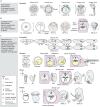The journey of a generation: advances and promises in the study of primordial germ cell migration
- PMID: 38607588
- PMCID: PMC11165723
- DOI: 10.1242/dev.201102
The journey of a generation: advances and promises in the study of primordial germ cell migration
Erratum in
-
Correction: The journey of a generation: advances and promises in the study of primordial germ cell migration.Development. 2024 May 15;151(10):dev203034. doi: 10.1242/dev.203034. Epub 2024 May 28. Development. 2024. PMID: 38804880 Free PMC article. No abstract available.
Abstract
The germline provides the genetic and non-genetic information that passes from one generation to the next. Given this important role in species propagation, egg and sperm precursors, called primordial germ cells (PGCs), are one of the first cell types specified during embryogenesis. In fact, PGCs form well before the bipotential somatic gonad is specified. This common feature of germline development necessitates that PGCs migrate through many tissues to reach the somatic gonad. During their journey, PGCs must respond to select environmental cues while ignoring others in a dynamically developing embryo. The complex multi-tissue, combinatorial nature of PGC migration is an excellent model for understanding how cells navigate complex environments in vivo. Here, we discuss recent findings on the migratory path, the somatic cells that shepherd PGCs, the guidance cues somatic cells provide, and the PGC response to these cues to reach the gonad and establish the germline pool for future generations. We end by discussing the fate of wayward PGCs that fail to reach the gonad in diverse species. Collectively, this field is poised to yield important insights into emerging reproductive technologies.
Keywords: ECM; Gonad; Migration; Primordial germ cells; Signaling.
© 2024. Published by The Company of Biologists Ltd.
Conflict of interest statement
Competing interests The authors declare no competing or financial interests.
Figures




Similar articles
-
Regulation of zebrafish primordial germ cell migration by attraction towards an intermediate target.Development. 2002 Jan;129(1):25-36. doi: 10.1242/dev.129.1.25. Development. 2002. PMID: 11782398
-
Primordial germ cell development in the marmoset monkey as revealed by pluripotency factor expression: suggestion of a novel model of embryonic germ cell translocation.Mol Hum Reprod. 2015 Jan;21(1):66-80. doi: 10.1093/molehr/gau088. Epub 2014 Sep 18. Mol Hum Reprod. 2015. PMID: 25237007 Free PMC article.
-
Germ cell migration-Evolutionary issues and current understanding.Semin Cell Dev Biol. 2020 Apr;100:152-159. doi: 10.1016/j.semcdb.2019.11.015. Epub 2019 Dec 19. Semin Cell Dev Biol. 2020. PMID: 31864795 Review.
-
The mechanical journey of primordial germ cells.Am J Physiol Cell Physiol. 2024 Dec 1;327(6):C1532-C1545. doi: 10.1152/ajpcell.00404.2024. Epub 2024 Oct 28. Am J Physiol Cell Physiol. 2024. PMID: 39466178 Review.
-
Primordial germ cell migration in the yellowtail kingfish (Seriola lalandi) and identification of stromal cell-derived factor 1.Gen Comp Endocrinol. 2015 Mar 1;213:16-23. doi: 10.1016/j.ygcen.2015.02.007. Epub 2015 Feb 20. Gen Comp Endocrinol. 2015. PMID: 25708429
Cited by
-
Origin and establishment of the germline in Drosophila melanogaster.Genetics. 2025 Apr 17;229(4):iyae217. doi: 10.1093/genetics/iyae217. Genetics. 2025. PMID: 40180587 Free PMC article. Review.
-
A positive feedback loop between germ cells and gonads induces and maintains sexual reproduction in a cnidarian.Sci Adv. 2025 Jan 10;11(2):eadq8220. doi: 10.1126/sciadv.adq8220. Epub 2025 Jan 8. Sci Adv. 2025. PMID: 39772697 Free PMC article.
-
Ap-Vas1 distribution unveils new insights into germline development in the parthenogenetic and viviparous pea aphid: from germ-plasm assembly to germ-cell clustering.Ann Entomol Soc Am. 2025 Feb 22;118(3):229-236. doi: 10.1093/aesa/saaf009. eCollection 2025 May. Ann Entomol Soc Am. 2025. PMID: 40415969 Free PMC article.
References
-
- Aeckerle, N., Drummer, C., Debowski, K., Viebahn, C. and Behr, R. (2015). Primordial germ cell development in the marmoset monkey as revealed by pluripotency factor expression: suggestion of a novel model of embryonic germ cell translocation. Mol. Hum. Reprod. 21, 552. 10.1093/molehr/gav016 - DOI - PMC - PubMed
-
- Alves-Lopes, J. P., Wong, F. C. K., Tang, W. W. C., Gruhn, W. H., Ramakrishna, N. B., Jowett, G. M., Jahnukainen, K. and Surani, M. A. (2023). Specification of human germ cell fate with enhanced progression capability supported by hindgut organoids. Cell Rep. 42, 111907. 10.1016/j.celrep.2022.111907 - DOI - PubMed
MeSH terms
Grants and funding
LinkOut - more resources
Full Text Sources

